External Validation of Equations to Estimate Resting Energy Expenditure in 2037 Children and Adolescents with and 389 without Obesity: A Cross-Sectional Study
Abstract
:1. Introduction
2. Materials and Methods
2.1. Study Design
2.2. Anthropometry
2.3. REE Measurement
2.4. REE Estimation
2.5. Statistical Analysis
3. Results
3.1. Study Population
3.2. Accuracy of the REE Prediction Equations
4. Discussion
4.1. Main Finding
4.2. Strengths and Limitations
4.3. Molnár REE Prediction Equation
4.4. Mifflin REE Prediction Equation
4.5. Other REE Prediction Equations
5. Conclusions
Author Contributions
Funding
Acknowledgments
Conflicts of Interest
Appendix A
| REE Prediction Equations (Pseudo-Code) |
| Legend: |
| age = age (years); |
| wt = body weight (kg); |
| htm = body height (m); |
| htcm = body height (cm); |
| male = male gender (0 = female; 1 = male); |
| if = if operator; |
| & = AND logical operator; |
| n = sample size used for the development of the given equation. |
| * |
| Harris–Benedict equation (kcal/day) (n = 136 men and 103 women): |
| 66.4730 + 13.7516*wt + 5.0033*htcm − 6.7550*age if male = 1 |
| 655.0955 + 9.5634*wt + 1.8496*htcm − 4.6756*age if male = 0 |
| * |
| Henry equation (MJ/day) (n = 1429 males and 1681 females): |
| 0.255*wt − 0.141 if male = 1 & age < 3 |
| 0.0937*wt + 2.15 if male = 1 & (age ≥ 3 & age < 10) |
| 0.0769*wt + 2.43 if male = 1 & (age ≥ 10 & age ≤ 18) |
| 0.246*wt − 0.0965 if male = 0 & age < 3 |
| 0.0842*wt + 2.12 if male = 0 & (age ≥ 3 & age < 10) |
| 0.0465*wt + 3.18 if male = 0 & (age ≥ 10 & age ≤ 18) |
| The u.m. is MJ/day. Multiply by 238.85 to obtain kcal/day. |
| * |
| ION NW equation (kcal/day) (n = 154 males and n = 397 females aged 3 to 18 years, with normal weight): |
| 68 − 43.3*age + 7.12*htcm + 19.2*wt if male = 1 |
| 189 − 17.6*age + 6.25*htcm + 7.9*wt if male = 0 |
| * |
| IOM OW and OB equation (kcal/day) (n = 157 males and n = 249 females aged 3 to 18 years, with overweight or obesity): |
| 419.9 − 35.5*age + 4.189*htcm + 16.7*wt if male = 1 |
| 515.8 − 26.8*age + 3.47*htcm + 12.4*wt if male = 0 |
| * |
| Mifflin equation (kcal/day) (n = 251 men and n = 247 women aged 19 to 78 years, with normal weight or obesity): |
| 10*wt + 6.25*htcm − 5.0*age – 161*male. |
| * |
| Molnár equation (KJ/day) (n = 193 boys and n = 178 girls aged 10 to 16 years, with normal weight or obesity): |
| 50.9*wt + 25.3*htcm − 50.3*age + 26.9 if male = 1 |
| 51.2*wt + 24.5*htcm − 207.5*age + 1629.8 if male = 0 |
| The u.m. is KJ/day. Divide by 4.184 to obtain kcal/d. |
| * |
| Müller equation (n = 243 boys and girls aged 5 to 17 years, with normal weight or obesity): |
| 0.02606*wt + 0.04129*htcm + 0.311*male − 0.08369*age − 0.808 |
| The u.m. is MJ/day. Multiply by 238.85 to obtain kcal/day. |
| * |
| Schofield weight equation (kcal/day) (n = 1072 males and n = 988 females): |
| 59.512*wt − 30.4 if male = 1 & age < 3 |
| 22.706*wt + 504.3 if male = 1 & (age ≥3 & age ≤10) |
| 17.686*wt + 658.2 if male = 1 & (age >10 & age ≤18) |
| 58.317*wt − 31.1 if male = 0 & age < 3 |
| 20.315*wt + 485.9 if male = 0 & (age ≥3 & age ≤10) |
| 13.384*wt + 692.6 if male = 0 & (age >10 & age ≤18) |
| * |
| Schofield weight and height equation (kcal/day) (n = 1072 males and n = 988 females): |
| 0.167*wt + 1517.4*htm − 617.6 if male = 1 & age < 3 |
| 19.60*wt + 130.3*htm + 414.9 if male = 1 & (age ≥3 & age ≤10) |
| 16.25*wt + 137.2*htm + 515.5 if male = 1 & (age >10 & age ≤18) |
| 16.25*wt + 1023.2*htm − 413.5 if male = 0 & age < 3 |
| 16.97*wt + 161.8*htm + 371.2 if male = 0 & (age ≥3 & age ≤10) |
| 8.365*wt + 465*htm + 200 if male = 0 & (age >10 & age ≤18) |
| * |
| WHO weight equation (kcal/day): |
| 60.9*wt – 54 if male = 1 & age < 3 |
| 22.7*wt + 495 if male = 1 & (age ≥3 & age ≤10) |
| 12.2*wt + 746 if male = 1 & (age >10 & age ≤18) |
| 61.0*wt – 51 if male = 0 & age < 3 |
| 22.4*wt + 499 if male = 0 & (age ≥3 & age ≤10) |
| 17.7*wt + 659 if male = 0 & (age >10 & age ≤18) |
Appendix B
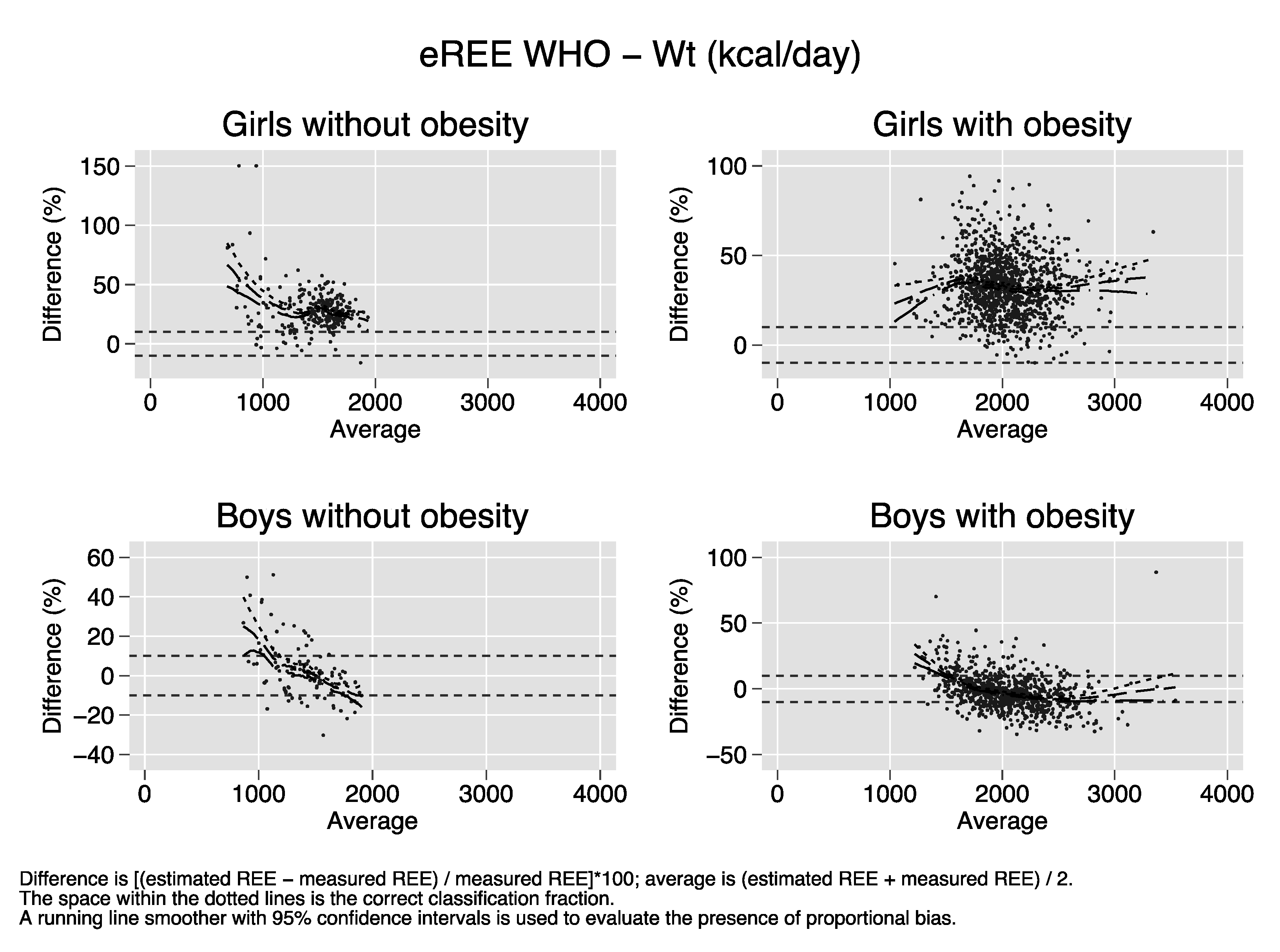
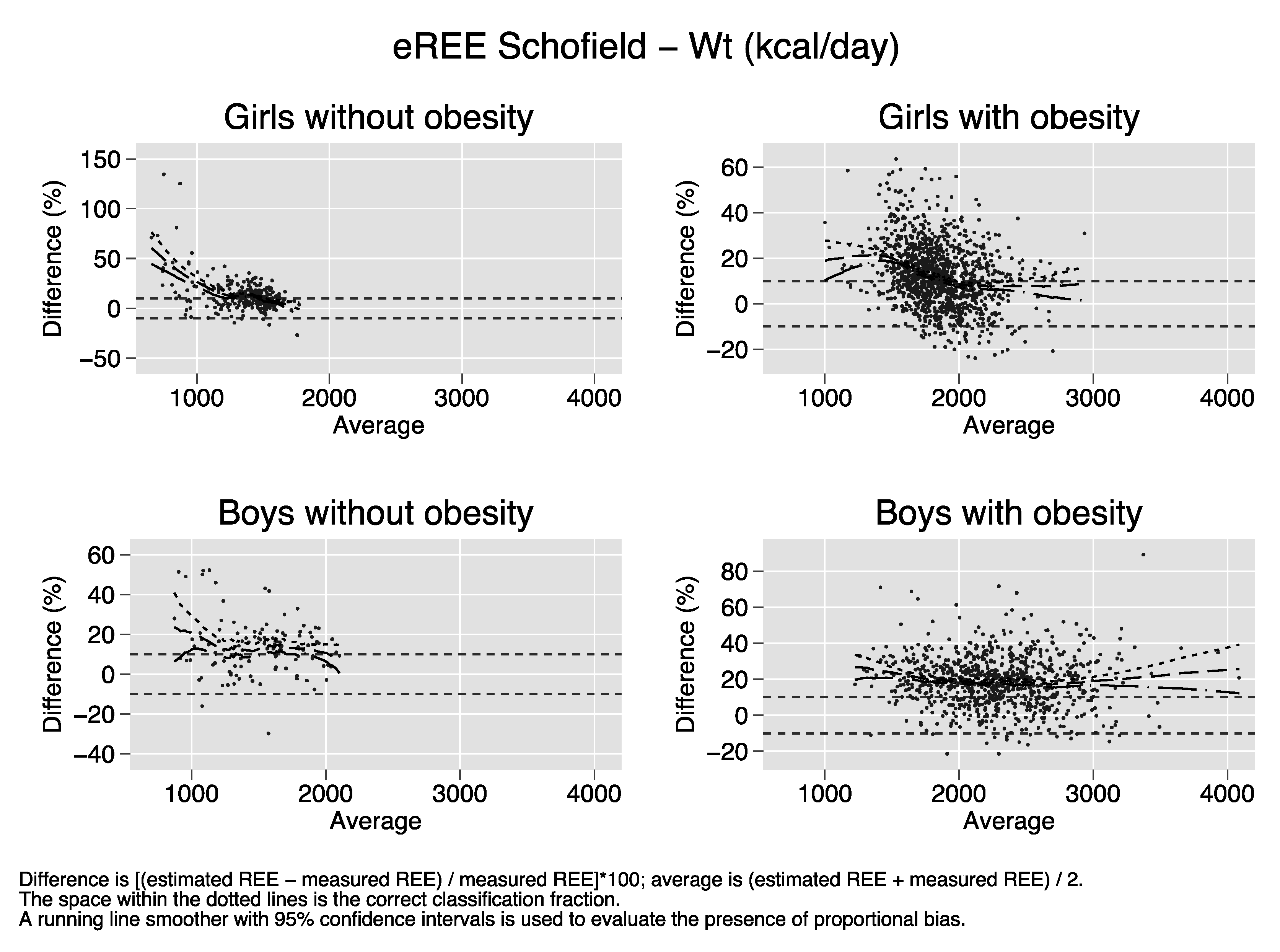
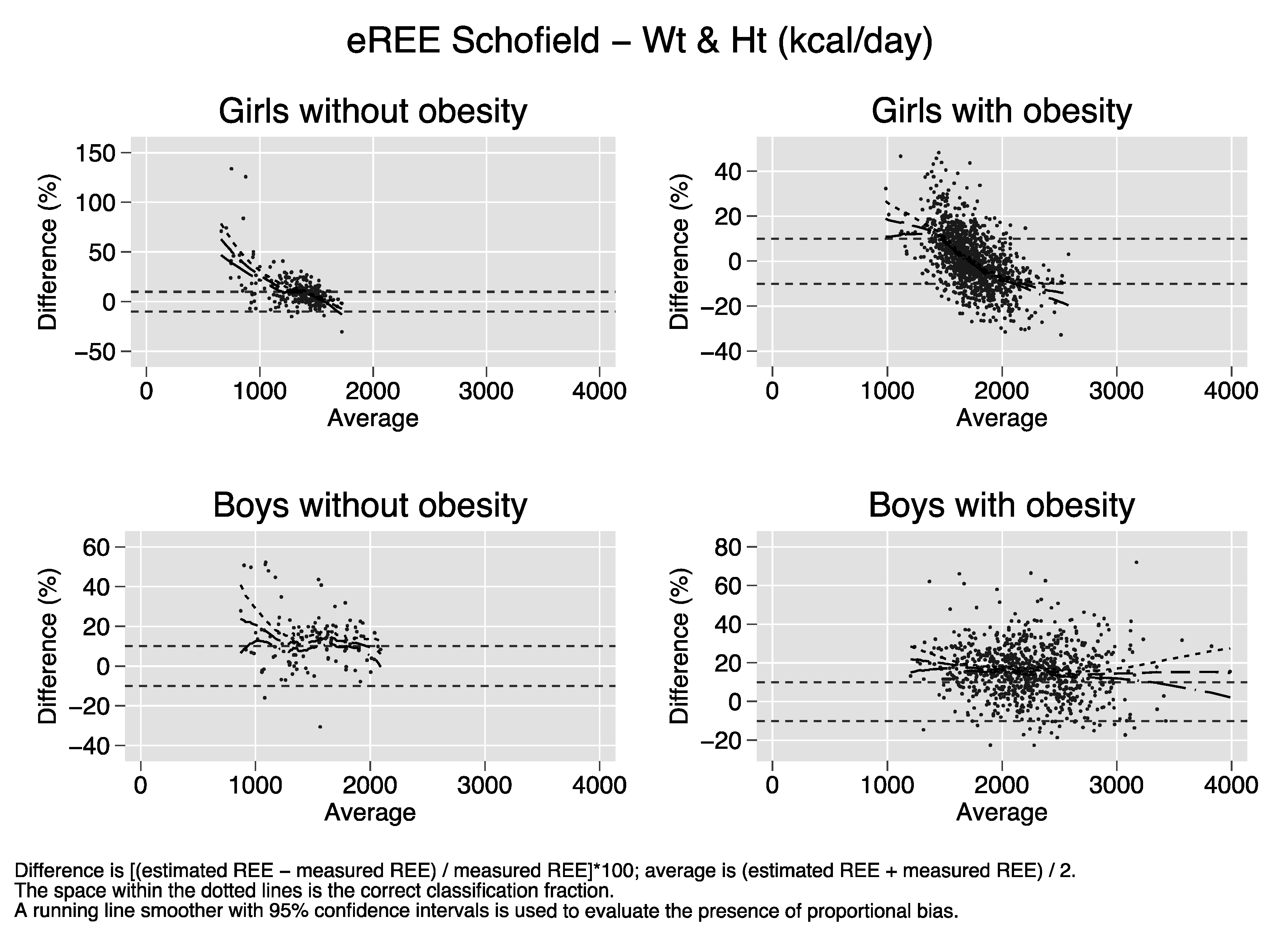
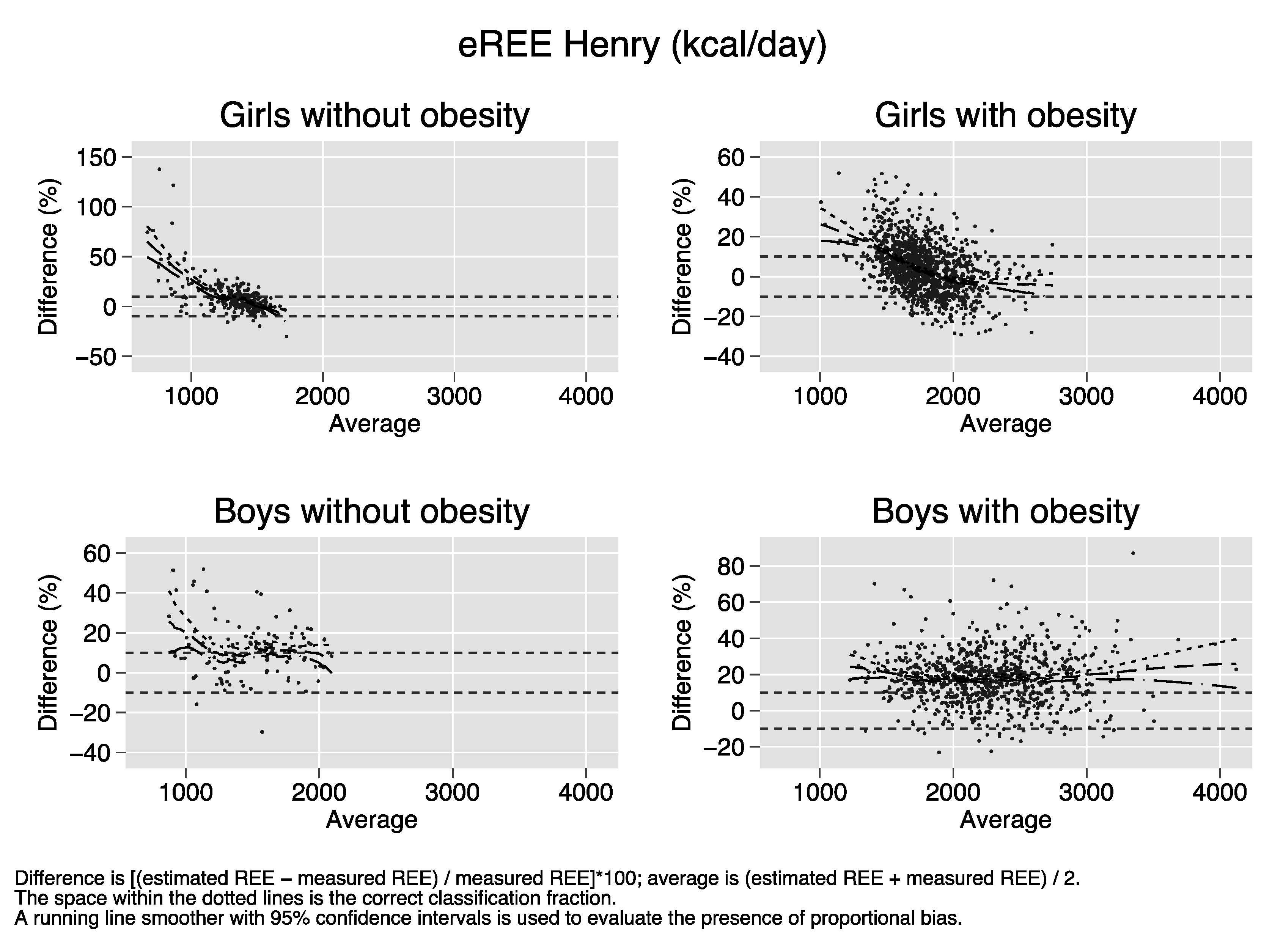
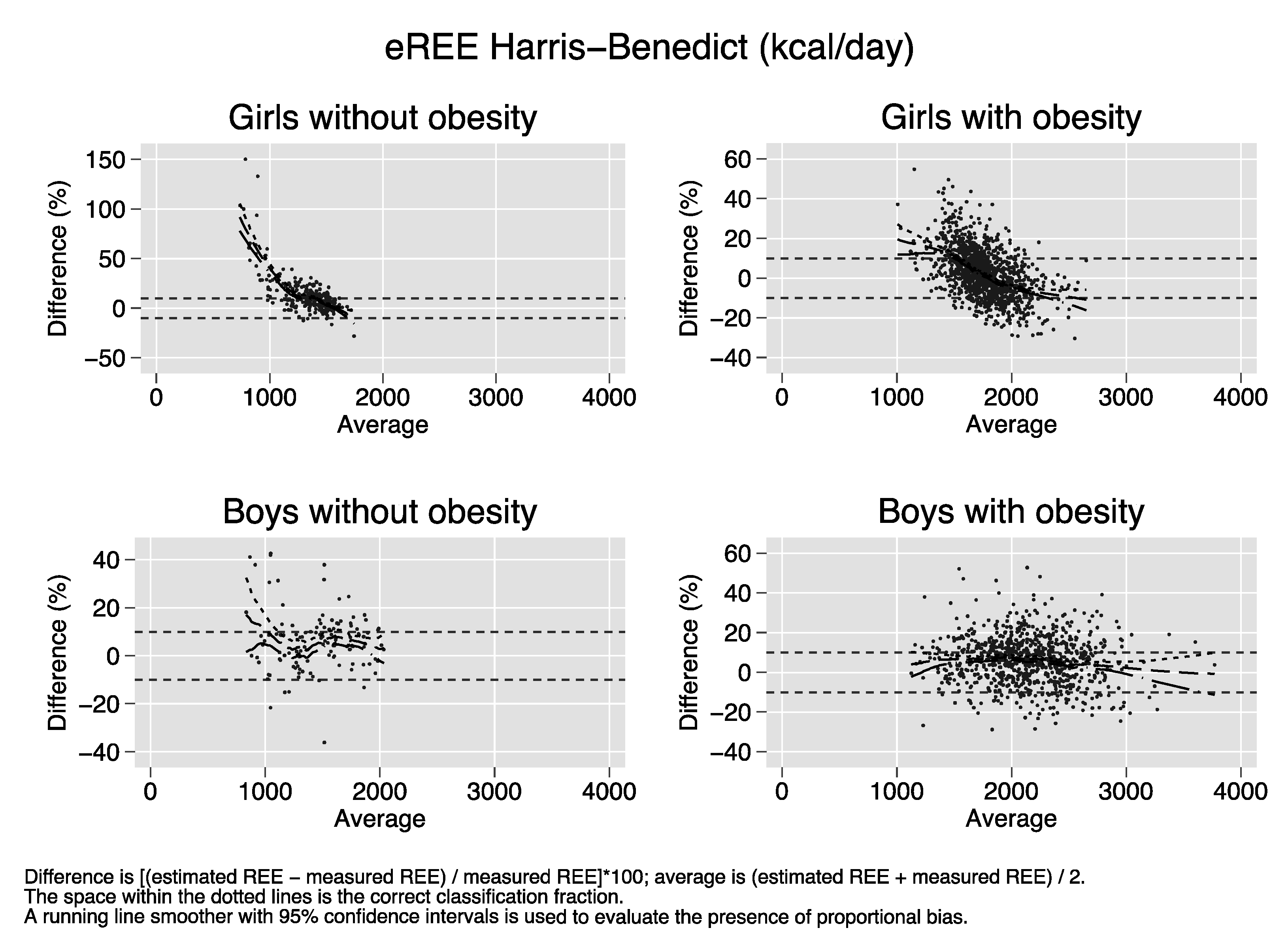

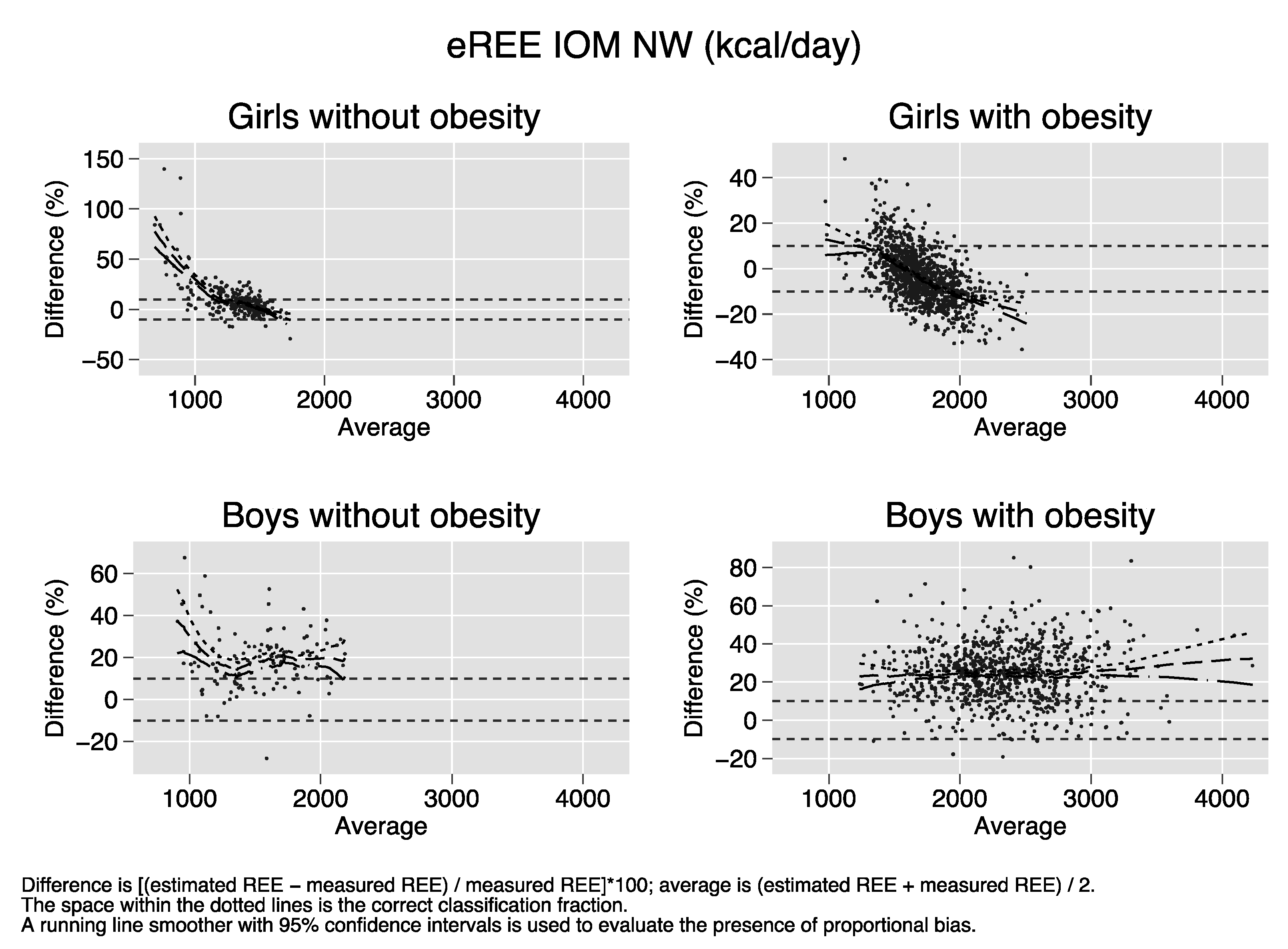

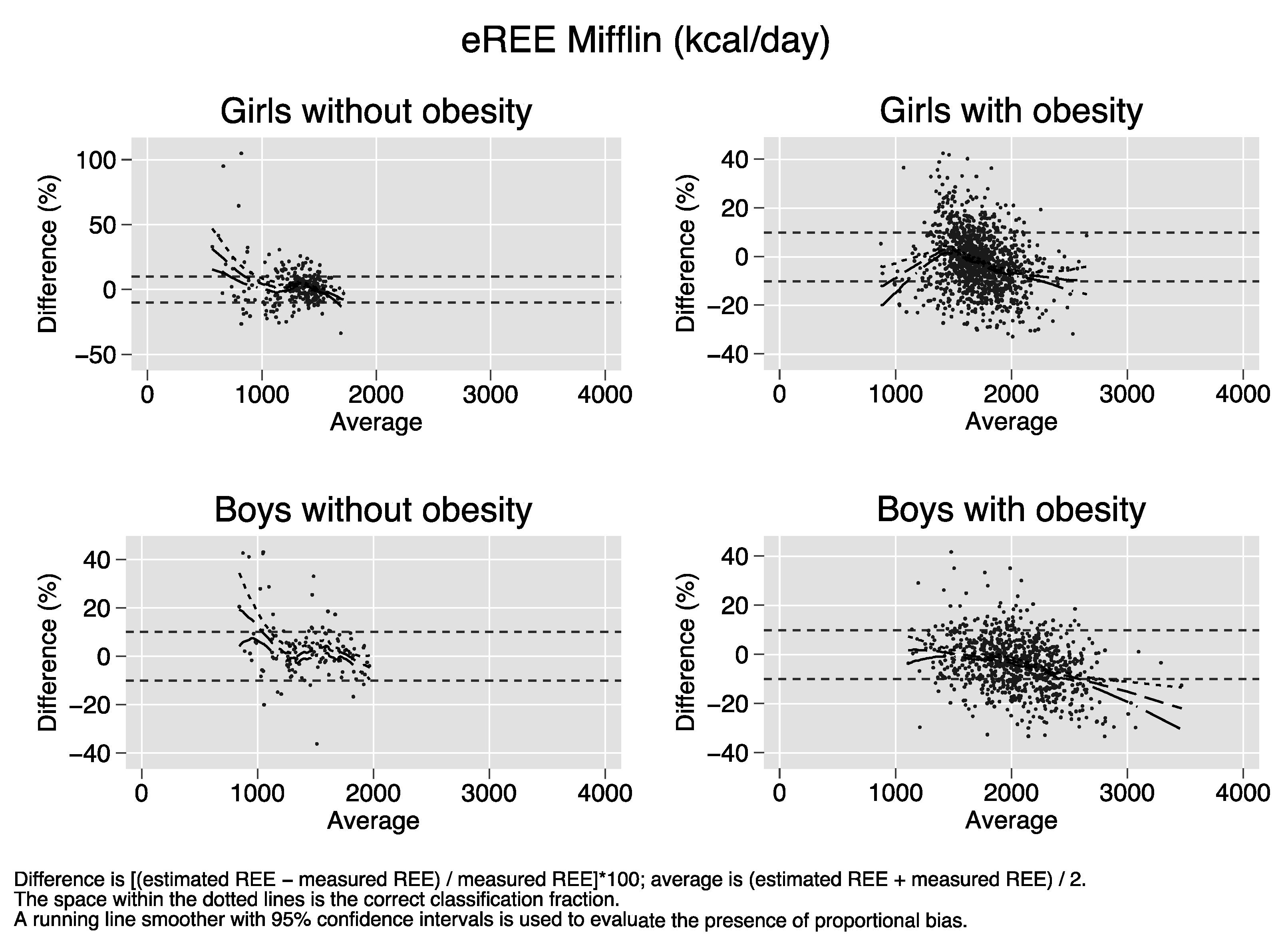
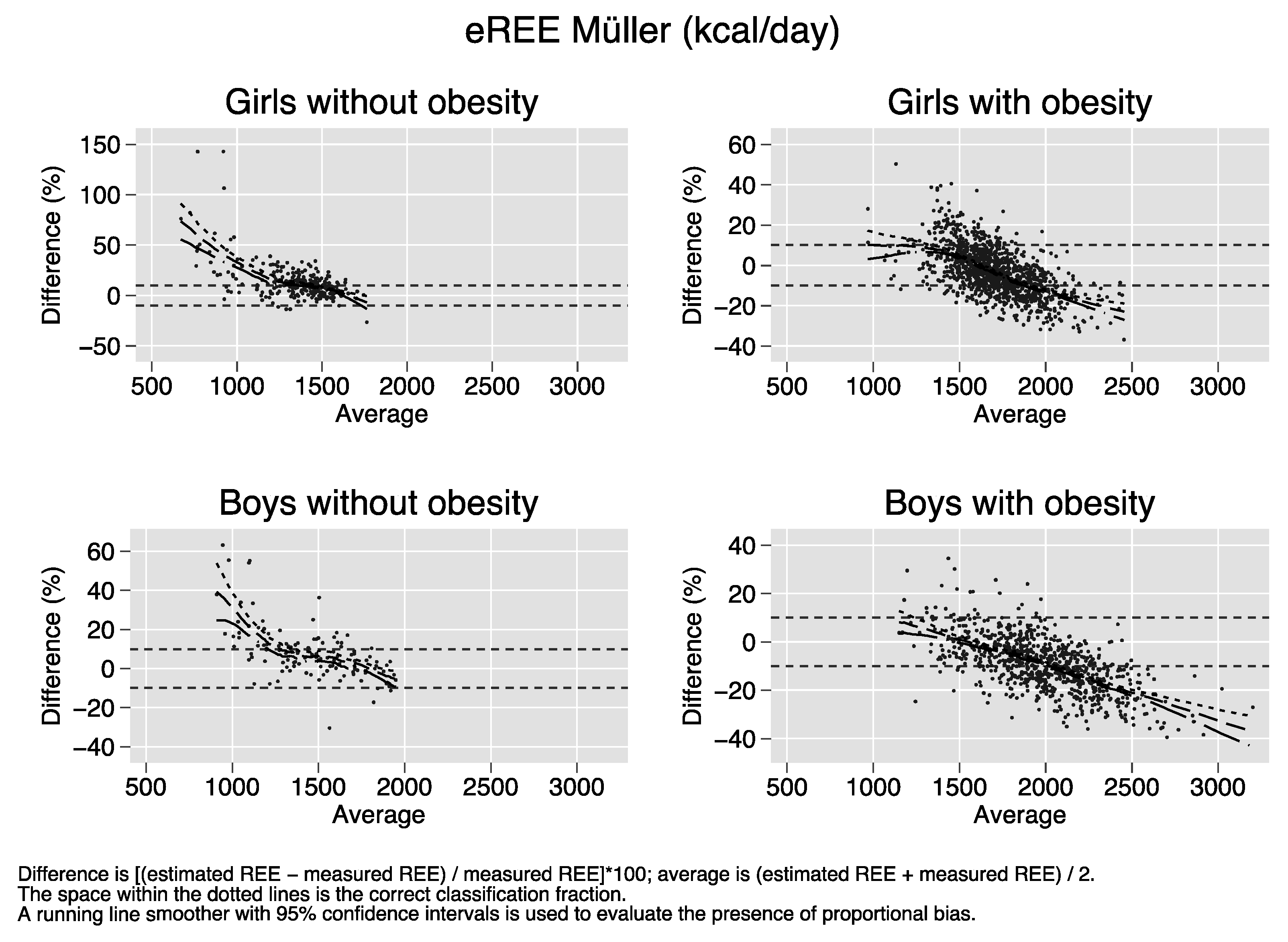
References
- Madden, A.M.; Mulrooney, H.; Shah, S. Estimation of energy expenditure using prediction equations in overweight and obese adults: A systematic review. J. Hum. Nutr. Diet. 2016, 29, 458–476. [Google Scholar] [CrossRef] [PubMed] [Green Version]
- Lam, Y.Y.; Ravussin, E. Indirect calorimetry: An indispensable tool to understand and predict obesity. Eur. J. Clin. Nutr. 2016, 71, 318–322. [Google Scholar] [CrossRef] [PubMed]
- Bedogni, G.; Bertoli, S.; Leone, A.; De Amicis, R.; Lucchetti, E.; Agosti, F.; Marazzi, N.; Battezzati, A.; Sartorio, A. External validation of equations to estimate resting energy expenditure in 14952 adults with overweight and obesity and 1948 adults with normal weight from Italy. Clin. Nutr. 2019, 38, 457–464. [Google Scholar] [CrossRef] [PubMed]
- Mifflin, M.D.; Jeor, S.T.S.; Hill, L.A.; Scott, B.J.; Daugherty, S.A.; Koh, Y.O. A new predictive equation for resting energy expenditure in healthy individuals. Am. J. Clin. Nutr. 1990, 51, 241–247. [Google Scholar] [CrossRef] [PubMed]
- Henry, C.J. Basal metabolic rate studies in humans: Measurement and development of new equations. Public Heal. Nutr. 2005, 8, 1133–1152. [Google Scholar] [CrossRef]
- Steinberg, A.; Manlhiot, C.; Cordeiro, K.; Chapman, K.; Pencharz, P.B.; McCrindle, B.W.; Hamilton, J. Determining the accuracy of predictive energy expenditure (PREE) equations in severely obese adolescents. Clin. Nutr. 2017, 36, 1158–1164. [Google Scholar] [CrossRef]
- Marra, M.; Montagnese, C.; Sammarco, R.; Amato, V.; Della Valle, E.; Franzese, A.; Contaldo, F.; Pasanisi, F. Accuracy of Predictive Equations for Estimating Resting Energy Expenditure in Obese Adolescents. J. Pediatr. 2015, 166, 1390–1396.e1. [Google Scholar] [CrossRef] [Green Version]
- Molnár, D.; Jeges, S.; Erhardt, E.; Schutz, Y. Measured and predicted resting metabolic rate in obese and nonobese adolescents. J. Pediatr. 1995, 127, 571–577. [Google Scholar] [CrossRef]
- Lazzer, S.; Agosti, F.; De Col, A.; Sartorio, A. Development and cross-validation of prediction equations for estimating resting energy expenditure in severely obese Caucasian children and adolescents. Br. J. Nutr. 2006, 96, 973–979. [Google Scholar] [CrossRef] [Green Version]
- Harris, J.A.; Benedict, F.G. A Biometric Study of Human Basal Metabolism. Proc. Natl. Acad. Sci. USA 1918, 4, 370–373. [Google Scholar] [CrossRef] [Green Version]
- Institute for Medicine of the National Academies, Food and Nutrition Board. Dietary Reference Intakes for Energy, Carbohydrate, Fiber, Fat, Fatty Acids, Cholesterol, Protein and Amino Acids; The National Academies Press: Washington, DC, USA, 2005. [Google Scholar]
- Schofield, W.N. Predicting basal metabolic rate, new standards and review of previous work. Hum. Nutr. Clin. Nutr. 1985, 39, 5–41. [Google Scholar] [PubMed]
- WHO Multicentre Growth Reference Study Group. Energy and Protein Requirements; Report of a joint FAO/WHO/UNU Expert Consultation; WHO: Geneva, Switzerland, 1985. [Google Scholar]
- Müller, M.J.; Bosy-Westphal, A.; Klaus, S.; Kreymann, G.; Lührmann, P.M.; Neuhäuser-Berthold, M.; Noack, R.; Pirke, K.M.; Platte, P.; Selberg, O.; et al. World Health Organization equations have shortcomings for predicting resting energy expenditure in persons from a modern, affluent population: Generation of a new reference standard from a retrospective analysis of a German database of resting energy expenditure. Am. J. Clin. Nutr. 2004, 80, 1379–1390. [Google Scholar] [CrossRef] [PubMed]
- Koletzko, B.; Goulet, O.; Hunt, J.; Krohn, K.; Shamir, R.; Parenteral Nutrition Guidelines Working Group; European Society for Clinical Nutrition and Metabolism; European Society of Paediatric Gastroenterology, Hepatology and Nutrition; European Society of Paediatric Research. Guidelines on Paediatric Parenteral Nutrition of the European Society of Paediatric Gastroenterology, Hepatology and Nutrition (ESPGHAN) and the European Society for Clinical Nutrition and Metabolism (ESPEN), Supported by the European Society of Paediatric Research (ESPR). J. Pediatr. Gastroenterol. Nutr. 2005, 41 (Suppl. 2), 5–11. [Google Scholar]
- Anonymous. Erratum. J. Pediatr. Gastroenterol. Nutr. 2013, 56, 460. [Google Scholar]
- Kaur, Y.; De Souza, R.J.; Gibson, W.T.; Meyre, D. A systematic review of genetic syndromes with obesity. Obes. Rev. 2017, 18, 603–634. [Google Scholar] [CrossRef]
- McClave, S.A.; Lowen, C.; Kleber, M.; McConnell, J.; Jung, L.; Goldsmith, L. Clinical use of the respiratory quotient obtained from indirect calorimetry. J. Parenter. Enter. Nutr. 2003, 27, 21–26. [Google Scholar] [CrossRef]
- Lohman, T.J.; Roache, A.F.; Martorell, R. Anthropometric Standardization Reference Manual. Med. Sci. Sports Exerc. 1992, 24, 952. [Google Scholar] [CrossRef] [Green Version]
- Cacciari, E.; Milani, S.; Balsamo, A.; Spada, E.; Bona, G.; Cavallo, L.; Cerutti, F.; Gargantini, L.; Greggio, N.; Tonini, G.; et al. Italian cross-sectional growth charts for height, weight and BMI (2 to 20 yr). J. Endocrinol Investig. 2006, 29, 581–593. [Google Scholar] [CrossRef]
- Weir, J.B.D.V. New methods for calculating metabolic rate with special reference to protein metabolism. J. Physiol. 1949, 109, 1–9. [Google Scholar] [CrossRef]
- Koenker, R. Quantile Regression; Cambridge University Press: Cambridge, UK, 2005. [Google Scholar]
- Machado, J.A.F.; Parente, P.M.D.C.; Santos Silva, J.M.C. QREG2: Stata Module to Perform Quantile Regression with Robust and Clustered Standard Errors; Statistical Software Components, Boston College Department of Economics: Boston, MA, USA, 2011. [Google Scholar]
- Agostoni, C.; Edefonti, A.; Calderini, E.; Fossali, E.; Colombo, C.; Battezzati, A.; Bertoli, S.; Milani, G.P.; Bisogno, A.; Perrone, M.; et al. Accuracy of Prediction Formulae for the Assessment of Resting Energy Expenditure in Hospitalized Children. J. Pediatr. Gastroenterol. Nutr. 2016, 63, 708–712. [Google Scholar] [CrossRef] [Green Version]
- Clopper, C.J.; Pearson, E.S. The Use of Confidence or Fiducial Limits Illustrated in the Case of the Binomial. Biometrika 1934, 26, 404–413. [Google Scholar] [CrossRef]
- Bosy-Westphal, A.; Braun, W.; Schautz, B.; Müller, M.J. Issues in characterizing resting energy expenditure in obesity and after weight loss. Front. Physiol. 2013, 4. [Google Scholar] [CrossRef] [Green Version]
- Marra, M.; Cioffi, I.; Sammarco, R.; Santarpia, L.; Contaldo, F.; Scalfi, L.; Pasanisi, F. Are Raw BIA Variables Useful for Predicting Resting Energy Expenditure in Adults with Obesity? Nutrients 2019, 11, 216. [Google Scholar] [CrossRef] [Green Version]

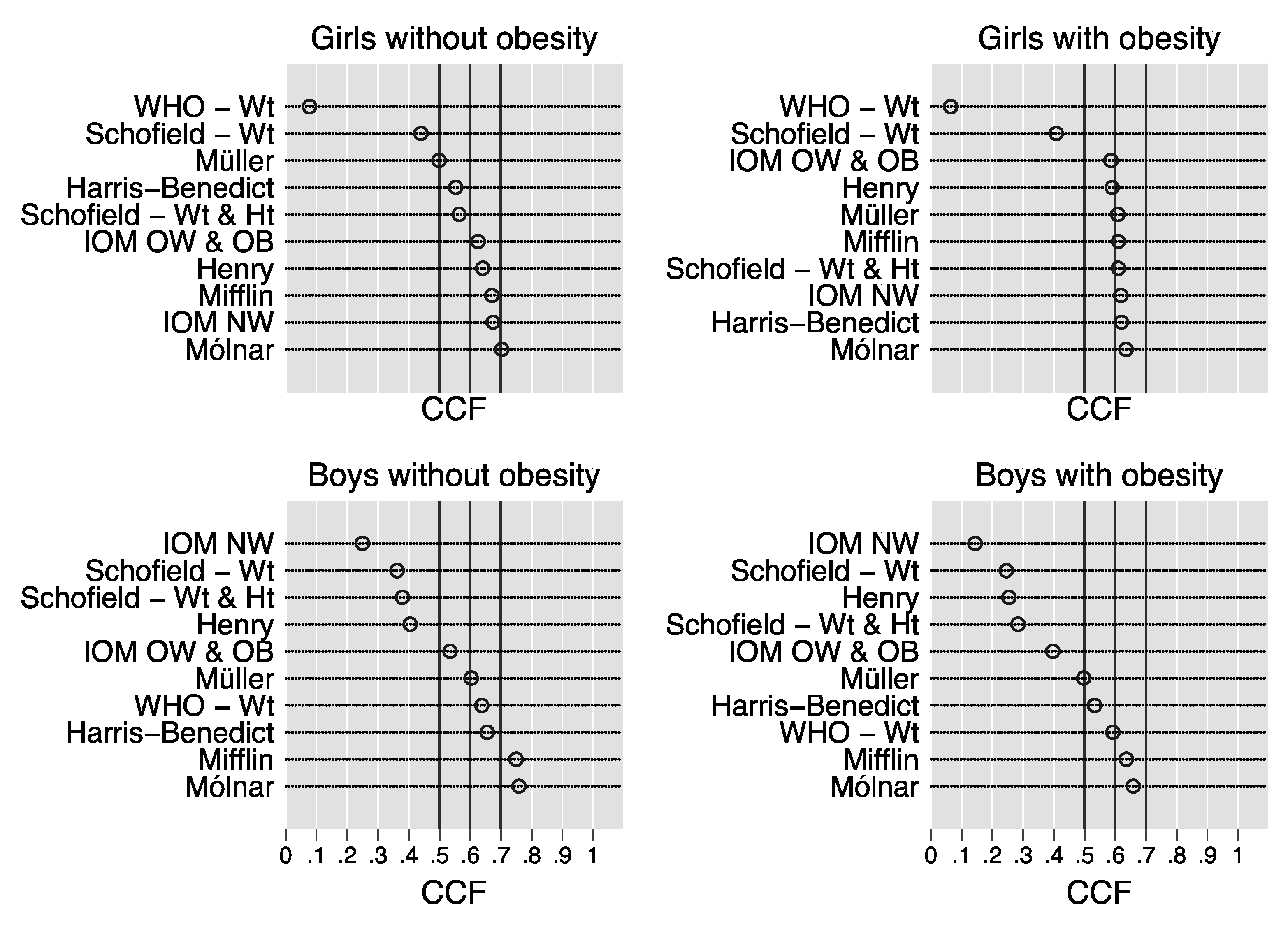
| Girls with Obesity | Boys without Obesity | Boys with Obesity | All Children | Girls with Obesity | |
|---|---|---|---|---|---|
| N = 273 | N = 1194 | N = 116 | N = 843 | N = 2426 | |
| Center | |||||
| Istituto Auxologico Italiano-Auxology | 4 (1.5%) | 1070 (89.6%) | 2 (1.7%) | 761 (90.3%) | 1837 (75.7%) |
| ICANS | 230 (84.2%) | 123 (10.3%) | 80 (69.0%) | 81 (9.6%) | 514 (21.2%) |
| Cà Granda | 39 (14.3%) | 1 (0.1%) | 34 (29.3%) | 1 (0.1%) | 75 (3.1%) |
| Sex | |||||
| Female | 273 (100.0%) | 1194 (100.0%) | 0 (0.0%) | 0 (0.0%) | 1467 (60.5%) |
| Male | 0 (0.0%) | 0 (0.0%) | 116 (100.0%) | 843 (100.0%) | 959 (39.5%) |
| Age (years) | 15 (12; 16) | 15 (13; 16) | 12 (10; 15) | 15 (12; 16) | 15 (13; 16) |
| Age category | |||||
| Children (< 13 years) | 103 (37.7%) | 295 (24.7%) | 76 (65.5%) | 264 (31.3%) | 738 (30.4%) |
| Adolescents (> 13 years) | 170 (62.3%) | 899 (75.3%) | 40 (34.5%) | 579 (68.7%) | 1688 (69.6%) |
| Weight (kg) | 59 (47; 66) | 91 (80; 103) | 56 (37; 67) | 100 (84; 118) | 89 (72; 106) |
| Weight (SDS Cacciari 2006) | 0.80 (0.05; 1.29) | 2.97 (2.38; 3.53) | 0.78 (0.04; 1.28) | 2.81 (2.30; 3.36) | 2.71 (1.97; 3.33) |
| Height (m) | 1.61 (1.52; 1.66) | 1.60 (1.55; 1.65) | 1.54 (1.41; 1.72) | 1.68 (1.58; 1.75) | 1.62 (1.55; 1.69) |
| Stature (SDS Cacciari 2006) | 0.56 (−0.17; 1.21) | 0.30 (−0.38; 1.04) | 0.81 (−0.10; 1.47) | 0.41 (−0.24; 1.14) | 0.39 (−0.28; 1.14) |
| BMI (kg/m2) | 23 (20; 25) | 35 (31; 39) | 21 (18; 24) | 35 (31; 40) | 34 (29; 39) |
| BMI (SDS Cacciari 2006) | 0.80 (−0.14; 1.19) | 2.80 (2.37; 3.23) | 0.69 (−0.30; 1.26) | 2.84 (2.35; 3.32) | 2.65 (2.08; 3.18) |
| BMI class (Cacciari 2006) | |||||
| Underweight | 4 (1.5%) | 0 (0.0%) | 2 (1.7%) | 0 (0.0%) | 6 (0.2%) |
| Normal weight | 168 (61.5%) | 0 (0.0%) | 71 (61.2%) | 0 (0.0%) | 239 (9.9%) |
| Overweight | 101 (37.0%) | 0 (0.0%) | 43 (37.1%) | 0 (0.0%) | 144 (5.9%) |
| Obesity | 0 (0.0%) | 1194 (100.0%) | 0 (0.0%) | 843 (100.0%) | 2037 (84.0%) |
| Respiratory quotient | 0.83 (0.79; 0.87) | 0.83 (0.77; 0.88) | 0.85 (0.82; 0.90) | 0.82 (0.77; 0.88) | 0.83 (0.78; 0.88) |
| mREE (kcal/day) | 1336 (1184; 1448) | 1719 (1552; 1925) | 1402 (1208; 1641) | 2085 (1812; 2356) | 1756 (1510; 2055) |
| mREE (kcal/kg weight/day) | 23 (21; 26) | 19 (17; 21) | 26 (24; 33) | 21 (19; 23) | 20 (18; 23) |
| eREE WHO-Wt (kcal/day) | 1712 * (1493; 1834) | 2273 * (2073; 2491) | 1441 * (1213; 1564) | 1975 * (1784; 2187) | 2079 * (1815; 2336) |
| eREE Schofield-Wt (kcal/day) | 1489 * (1327; 1583) | 1915 * (1769; 2078) | 1648 * (1311; 1839) | 2432 * (2144; 2740) | 1968 * (1729; 2319) |
| eREE Schofield-Wt and Ht (kcal/day) | 1448 * (1321; 1525) | 1716 * (1612; 1830) | 1644 * (1312; 1841) | 2370 * (2099; 2667) | 1779 * (1604; 2168) |
| eREE Henry (kcal/day) | 1418 * (1287; 1497) | 1776 * (1653; 1910) | 1608 * (1267; 1806) | 2423 * (2121; 2742) | 1842 * (1633; 2221) |
| eREE Harris–Benedict (kcal/day) | 1455 * (1329; 1525) | 1754 * (1642; 1870) | 1540 * (1227; 1751) | 2190 * (1938; 2448) | 1791 * (1605; 2067) |
| eREE Molnár (kcal/day) | 1320 * (1182; 1435) | 1706 * (1565; 1862) | 1491 * (1204; 1687) | 2070 * (1835; 2305) | 1750 * (1529; 2010) |
| eREE IOM NW (kcal/day) | 1411 * (1283; 1484) | 1651 * (1553; 1761) | 1693 * (1349; 1916) | 2556 * (2242; 2898) | 1735 * (1551; 2300) |
| eREE IOM OW and OB (kcal/day) | 1423 * (1259; 1510) | 1804 * (1669; 1954) | 1543 * (1266; 1720) | 2279 * (2021; 2572) | 1857 * (1632; 2173) |
| eREE Mifflin (kcal/day) | 1367 * (1211; 1459) | 1682 * (1554; 1817) | 1475 * (1228; 1690) | 1990 * (1778; 2194) | 1714 * (1520; 1944) |
| eREE Müller (kcal/day) | 1471 * (1341; 1558) | 1660 * (1566; 1761) | 1514 * (1311; 1711) | 1875 * (1714; 2033) | 1687 * (1552; 1847) |
| Girls without Obesity | Girls with Obesity | Boys without Obesity | Boys with Obesity | All Children | |
|---|---|---|---|---|---|
| N = 273 | N = 1194 | N = 116 | N = 843 | N = 2426 | |
| WHO-Wt bias (kcal/day) | 364 (261; 447) | 548 (385; 715) | −1 (−94; 80) | −64 (−236; 88) | 318 (−1; 557) |
| WHO-Wt bias (%) | 27 (20; 35) | 32 (22; 43) | 0 (−6; 7) | −3 (−11; 5) | 20 (0; 35) |
| WHO-Wt MAPE (%, mean) | 29 | 33 | 10 | 10 | 24 |
| WHO-Wt CCF | 21 (7.7%) | 77 (6.4%) | 74 (63.8%) | 499 (59.2%) | 671 (27.7%) |
| Schofield-Wt bias (kcal/day) | 148 (64; 224) | 202 (66; 334) | 197 (66; 287) | 373 (200; 530) | 236 (95; 391) |
| Schofield-Wt bias (%) | 11 (5; 18) | 12 (4; 21) | 14 (5; 20) | 19 (10; 27) | 14 (6; 23) |
| Schofield-Wt MAPE (%, mean) | 15 | 15 | 16 | 20 | 17 |
| Schofield-Wt CCF | 120 (44.0%) | 486 (40.7%) | 42 (36.2%) | 207 (24.6%) | 855 (35.2%) |
| Schofield-Wt and Ht bias (kcal/day) | 108 (26; 186) | 2 (−139; 124) | 186 (65; 269) | 309 (148; 459) | 109 (−48; 276) |
| Schofield-Wt and Ht bias (%) | 8 (2; 15) | 0 (−7; 8) | 13 (5; 19) | 16 (7; 24) | 7 (−3; 17) |
| Schofield-Wt and Ht MAPE (%, mean) | 13 | 9 | 15 | 17 | 13 |
| Schofield-Wt and Ht CCF | 154 (56.4%) | 729 (61.1%) | 44 (37.9%) | 239 (28.4%) | 1166 (48.1%) |
| Henry bias (kcal/day) | 80 (1; 164) | 64 (−69; 191) | 164 (53; 264) | 356 (178; 525) | 143 (−2; 321) |
| Henry bias (%) | 6 (0; 13) | 4 (−4; 12) | 12 (3; 18) | 18 (9; 27) | 9 (0; 19) |
| Henry MAPE (%, mean) | 12 | 10 | 14 | 20 | 14 |
| Henry CCF | 175 (64.1%) | 705 (59.0%) | 47 (40.5%) | 214 (25.4%) | 1141 (47.0%) |
| Harris–Benedict bias (kcal/day) | 113 (36; 194) | 34 (−96; 153) | 81 (−24; 166) | 124 (−43; 263) | 77 (−58; 199) |
| Harris–Benedict bias (%) | 8 (2; 16) | 2 (−5; 10) | 6 (−2; 11) | 6 (−2; 14) | 4 (−3; 12) |
| Harris–Benedict MAPE (%, mean) | 14 | 9 | 10 | 11 | 10 |
| Harris–Benedict CCF | 151 (55.3%) | 740 (62.0%) | 76 (65.5%) | 449 (53.3%) | 1416 (58.4%) |
| Molnár bias (kcal/day) | 22 (−67; 87) | −7 (−138; 124) | 36 (−52; 113) | 9 (−148; 146) | 5 (−125; 126) |
| Molnár bias (%) | 2 (−5; 8) | 0 (−8; 7) | 3 (−4; 8) | 1 (−7; 8) | 0 (−7; 8) |
| Molnár MAPE (%, mean) | 11 | 9 | 9 | 9 | 9 |
| Molnár CCF | 192 (70.3%) | 758 (63.5%) | 88 (75.9%) | 555 (65.8%) | 1593 (65.7%) |
| IOM NW bias (kcal/day) | 68 (−7; 150) | −64 (−201; 49) | 260 (141; 358) | 491 (298; 675) | 87 (−86; 360) |
| IOM NW bias (%) | 5 (−1; 12) | −4 (−11; 3) | 18 (10; 26) | 25 (14; 34) | 6 (−5; 21) |
| IOM NW MAPE (%, mean) | 11 | 9 | 20 | 25 | 16 |
| IOM NW CCF | 184 (67.4%) | 738 (61.8%) | 29 (25.0%) | 121 (14.4%) | 1072 (44.2%) |
| IOM OW and OB bias (kcal/day) | 78 (18; 169) | 87 (−46; 212) | 127 (15; 207) | 229 (61; 368) | 126 (1; 262) |
| IOM OW and OB bias (%) | 6 (1; 14) | 5 (−2; 13) | 9 (1; 15) | 11 (3; 19) | 7 (0; 16) |
| IOM OW and OB MAPE (%, mean) | 12 | 10 | 12 | 14 | 12 |
| IOM OW and OB CCF | 171 (62.6%) | 700 (58.6%) | 62 (53.4%) | 335 (39.7%) | 1268 (52.3%) |
| Mifflin bias (kcal/day) | 19 (−71; 97) | −46 (−180; 73) | 32 (−46; 104) | −72 (−226; 58) | −39 (−175; 76) |
| Mifflin bias (%) | 1 (−6; 8) | −3 (−10; 5) | 2 (−3; 8) | −3 (−11; 3) | −2 (−9; 5) |
| Mifflin MAPE (%, mean) | 10 | 9 | 8 | 9 | 9 |
| Mifflin CCF | 183 (67%) | 728 (61%) | 87 (75%) | 536 (64%) | 1534 (63%) |
| Müller bias (kcal/day) | 130 (47; 204) | −65 (−197; 60) | 85 (1; 163) | −180 (−364; −40) | −65 (−243; 72) |
| Müller bias (%) | 10 (3; 18) | −4 (−11; 4) | 6 (0; 13) | −9 (−16; −2) | −4 (−12; 5) |
| Müller MAPE (%, mean) | 14 | 9 | 11 | 12 | 11 |
| Müller CCF | 136 (50%) | 726 (61%) | 70 (60%) | 419 (50%) | 1351 (56%) |
© 2020 by the authors. Licensee MDPI, Basel, Switzerland. This article is an open access article distributed under the terms and conditions of the Creative Commons Attribution (CC BY) license (http://creativecommons.org/licenses/by/4.0/).
Share and Cite
Bedogni, G.; Bertoli, S.; De Amicis, R.; Foppiani, A.; De Col, A.; Tringali, G.; Marazzi, N.; De Cosmi, V.; Agostoni, C.; Battezzati, A.; et al. External Validation of Equations to Estimate Resting Energy Expenditure in 2037 Children and Adolescents with and 389 without Obesity: A Cross-Sectional Study. Nutrients 2020, 12, 1421. https://doi.org/10.3390/nu12051421
Bedogni G, Bertoli S, De Amicis R, Foppiani A, De Col A, Tringali G, Marazzi N, De Cosmi V, Agostoni C, Battezzati A, et al. External Validation of Equations to Estimate Resting Energy Expenditure in 2037 Children and Adolescents with and 389 without Obesity: A Cross-Sectional Study. Nutrients. 2020; 12(5):1421. https://doi.org/10.3390/nu12051421
Chicago/Turabian StyleBedogni, Giorgio, Simona Bertoli, Ramona De Amicis, Andrea Foppiani, Alessandra De Col, Gabriella Tringali, Nicoletta Marazzi, Valentina De Cosmi, Carlo Agostoni, Alberto Battezzati, and et al. 2020. "External Validation of Equations to Estimate Resting Energy Expenditure in 2037 Children and Adolescents with and 389 without Obesity: A Cross-Sectional Study" Nutrients 12, no. 5: 1421. https://doi.org/10.3390/nu12051421






